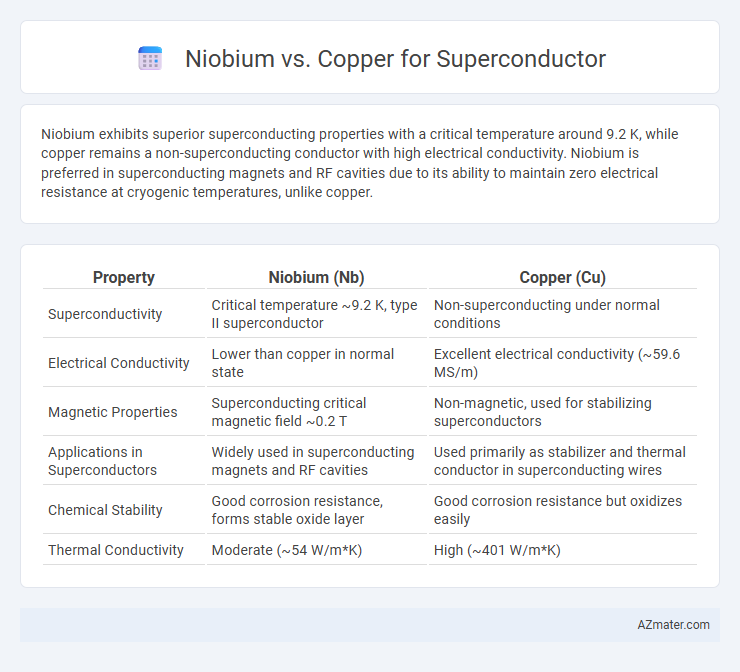Niobium exhibits superior superconducting properties with a critical temperature around 9.2 K, while copper remains a non-superconducting conductor with high electrical conductivity. Niobium is preferred in superconducting magnets and RF cavities due to its ability to maintain zero electrical resistance at cryogenic temperatures, unlike copper.
Table of Comparison
| Property | Niobium (Nb) | Copper (Cu) |
|---|---|---|
| Superconductivity | Critical temperature ~9.2 K, type II superconductor | Non-superconducting under normal conditions |
| Electrical Conductivity | Lower than copper in normal state | Excellent electrical conductivity (~59.6 MS/m) |
| Magnetic Properties | Superconducting critical magnetic field ~0.2 T | Non-magnetic, used for stabilizing superconductors |
| Applications in Superconductors | Widely used in superconducting magnets and RF cavities | Used primarily as stabilizer and thermal conductor in superconducting wires |
| Chemical Stability | Good corrosion resistance, forms stable oxide layer | Good corrosion resistance but oxidizes easily |
| Thermal Conductivity | Moderate (~54 W/m*K) | High (~401 W/m*K) |
Introduction: The Search for Ideal Superconductor Materials
Niobium and copper serve distinct roles in superconductor applications, with niobium being a critical element in producing high-performance superconducting materials like niobium-titanium and niobium-tin alloys. Copper, while not superconducting itself, is essential for its excellent electrical conductivity and thermal stability in superconducting wire composites, facilitating efficient current transfer and mechanical support. The search for ideal superconductor materials prioritizes niobium-based compounds due to their higher critical temperature and magnetic field thresholds compared to copper, making niobium alloys central to advanced superconducting technologies.
Fundamental Properties: Niobium vs Copper
Niobium is a type-II superconductor with a critical temperature around 9.3 K, enabling zero electrical resistance and strong magnetic field expulsion below this temperature. Copper, a normal metal, lacks superconducting properties and maintains significant electrical resistance even at very low temperatures. Niobium's crystalline structure and electron-phonon coupling facilitate Cooper pair formation, whereas copper's electron scattering prevents superconductivity.
Superconducting Mechanisms in Niobium
Niobium exhibits superconductivity primarily due to its strong electron-phonon coupling, which facilitates Cooper pair formation below its critical temperature of 9.2 K. Unlike copper, which is a normal conductor without a superconducting phase under standard conditions, niobium's lattice vibrations enable the electron pairing mechanism essential for zero electrical resistance. This intrinsic superconducting mechanism positions niobium as a preferred material for superconducting magnets and quantum computing applications.
Copper’s Limitations in Superconductivity
Copper's limitations in superconductivity stem from its intrinsic electronic structure, which lacks the necessary electron pairing mechanism critical for superconducting states. Unlike niobium, a well-known type-II superconductor with a high critical temperature and magnetic field tolerance, copper remains a normal conductor even at cryogenic temperatures due to strong electron scattering and the absence of Cooper pairs formation. Consequently, copper cannot exhibit zero electrical resistance or perfect diamagnetism, restricting its application in superconducting technologies that demand efficient energy transmission and magnetic flux exclusion.
Critical Temperature Comparison
Niobium exhibits a significantly higher critical temperature (Tc) of approximately 9.2 K compared to copper, which is not superconducting under standard conditions. This makes niobium a preferred choice for superconductor applications requiring reliable superconductivity at relatively higher cryogenic temperatures. Copper serves mainly as a stabilizer or electrical conductor but lacks intrinsic superconducting properties.
Electrical and Magnetic Performance
Niobium outperforms copper in electrical performance as it exhibits zero electrical resistance below its critical temperature, making it a superior superconductor for efficiently conducting current without energy loss. Its magnetic properties allow it to maintain superconductivity under strong magnetic fields, with a critical magnetic field significantly higher than copper's non-superconducting magnetism. Copper, while highly conductive at room temperature, lacks superconducting capabilities and experiences resistive losses, limiting its efficiency in high-performance electrical and magnetic applications.
Practical Applications in Technology
Niobium-based superconductors, such as NbTi and Nb3Sn, dominate practical applications in MRI machines, particle accelerators, and fusion reactors due to their high critical magnetic fields and current-carrying capacity. Copper, while not superconducting itself, is widely used as a stabilizing and conductive matrix in superconducting wires to enhance mechanical strength and thermal stability. The combination of niobium's superconducting properties with copper's excellent electrical conductivity enables the fabrication of reliable, high-performance superconducting magnets crucial for advanced technological applications.
Material Availability and Processing
Niobium is more abundant than commonly perceived, with large reserves primarily found in Brazil and Canada, whereas copper is widely distributed and highly accessible globally. Processing niobium into superconducting wire requires specialized techniques such as alloying with titanium or tin and precise heat treatments to achieve optimal critical magnetic fields and transition temperatures. Copper, while easier to process and more cost-effective for electrical applications, does not exhibit superconductivity at practical temperatures, limiting its use to stabilizing niobium-based superconducting composites rather than serving as a primary superconductor material.
Cost-Efficiency and Scalability
Niobium offers superior superconducting properties with higher critical temperature and magnetic field thresholds compared to copper, making it more cost-efficient for high-performance applications despite its higher raw material cost. Copper, while cheaper and more abundant, lacks intrinsic superconductivity and requires additional cooling and material costs to achieve comparable performance, reducing overall scalability in large-scale superconducting systems. Niobium's established fabrication techniques and material availability support scalable production for industrial superconducting technologies.
Future Prospects in Superconductor Research
Niobium-based superconductors, particularly Nb3Sn and NbTi, remain foundational in high-field applications due to their high critical magnetic fields and stability. Copper, though not a superconductor itself, plays a crucial role as a stabilizing matrix in many superconducting wires, enhancing thermal conductivity and mechanical strength. Future research aims to optimize Nb-based materials' microstructure and combine them with advanced copper alloys to develop more efficient, durable superconducting systems for quantum computing and fusion energy.

Infographic: Niobium vs Copper for Superconductor
 azmater.com
azmater.com